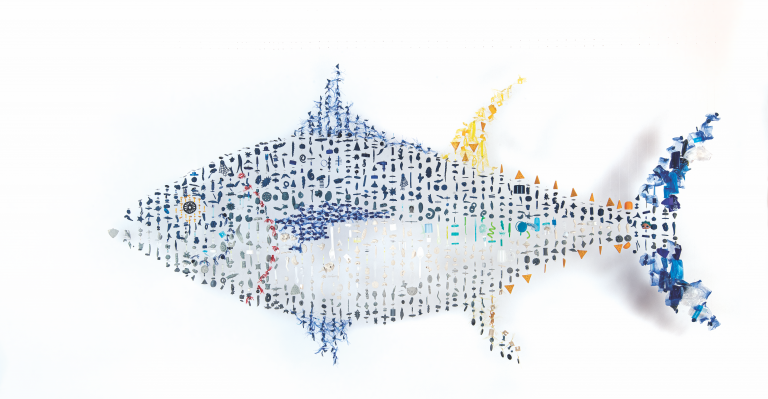Canadian Geographic commissioned five artists to create works out of plastic waste. One in a five part series.
The results? Eye-catching and compelling commentary on the material’s impact on our planet.
One in a five part series.
It was a powerful statement. For much of 2019, as visitors left Ripley’s Aquarium of Canada in Toronto, they were confronted with a silver canoe emerging from a tidal wave of plastic water bottles. What to make of this iconic Canadian symbol of water and wilderness engulfed in the seemingly ubiquitous empty bottles, a work titled Over Our Heads?
Questioning our dependence on plastic and the waste it’s creating is principal motive behind the 10,000 Changes program from Canadian Geographic, together with Environment and Climate Change Canada and the Recycling Council of Ontario. As part of the initiative, Canadian Geographic wanted to inspire reflection on plastic similar to that prompted by the Ripley’s exhibit. So, we commissioned five Canadian artists to create works from plastic waste and share the rationale behind their art to provoke further thought on the issue.
Included among them is the very artist of the Ripley’s piece, Rebecca Jane Houston, along with Pete Clarkson, Katharine Harvey, Kerry Hodgson and Hilde Lambrechts. Some, like Houston, are already known for plastic waste art, while others mixed plastic into their existing mediums. All present pieces that will inspire us to rethink plastic. Here’s the first.
Blue Fin Tuna
by Hilde Lambrechts

My work focuses on the environmental and social issues of our time. Blue Fin Tuna is a statement about the depletion of marine food sources and the plastic contamination in our food and oceans. The installation comprises hundreds of ceramic plankton sculptures and plastic garbage to form a two-dimensional blue fin tuna, true to size and colour.
Blue fin tuna are overfished globally, which I acknowledged by hanging the individual components from plastic fishing wire. And I included sculptures of both phytoplankton and zooplankton because of their importance to the aquatic food chain. As nutrients, they eventually become a part of larger fish species, exemplified by the tuna. The small sculptures are predominantly hand-built in porcelain and loosely based on plankton morphology. They are stained with underglazes, glazed and/or painted with acrylic, yet another plastic material.
The plastic garbage used in the artwork was collected from the North Sea beach in Belgium during a vacation, from a hospital lab, from the street and from several households for the duration of one year. In that sense, the work is a testament to the types of plastic used every day in 2019, including lids and cups, rope, acrylic yarn, cutlery, buttons, beads, toys, straws, clips, fasteners, a dental floss pick, a toothbrush, expired identification cards, hotel keys, tubes, a loofah and a range of packaging materials. Once in the water, these objects break down into micro- and nan0-plastics, which move through the food chain to end up on our plates — we truly are what we eat.
